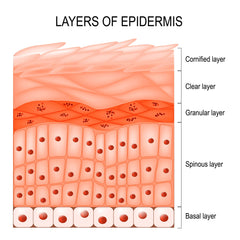
SKIN CELL RENEWAL—EVERYTHING YOU NEED TO KNOW IN JUST 5 MINUTES
Published February 25, 2024
The term “cell renewal” is one that most of us have heard at least once. But what exactly does it mean? What exactly does this process do to skin cells? In this article, Laboratoires FILORGA's skin experts will tell you everything you need to know about skin cell regeneration and how to stimulate it.
SO, WHAT IS CELL RENEWAL?
Like the rest of our organs, the skin and the cells it's made of are constantly being renewed. This natural regenerative process occurs all through our lives and is essential for:
- Maintaining a radiant complexion.
- Maintaining the skin's youthfulness, elasticity, and firmness.
- Maintaining its function as a protective barrier against pathogenic microorganisms and the various other external stresses that the body is constantly exposed to (cold, pollution, UV radiation, etc.).
The skin's ability to renew itself relies on the replacement of dead cells with new ones. This cell turnover process involves the removal of dead cells from the skin's surface, allowing new cells to replace them.
HOW SKIN CELLS RENEW THEMSELVES
“Skin cell renewal” is primarily used in reference to the renewal of cells of the skin's outer layer, the epidermis, and more specifically to the life cycle of keratinocytes.
WHAT ARE KERATINOCYTES?
All the cells that make up the epidermis are bound together and adhere to each other to form a physical barrier. Keratinocytes account for around 80–90% of epidermal cells. They form several layers and produce keratin, which is the building block of various parts of different animals: skin, hair, nails, rhino horns, feathers, beaks, etc. This stiff protein gives the skin:
- Mechanical resistance.
- Resistance to knocks and impacts.
- Impermeability, because keratin is insoluble in water.
Keratin is therefore crucial to the protective barrier between our body and the environment.
THE BIRTH, LIFE, AND DEATH OF KERATINOCYTE
Keratinocytes assemble into 4 different layers within the epidermis. They are, from the innermost to the outermost:

1. THE BASAL LAYER (THE DEEPEST LAYER)
Keratinocytes are produced in the basal layer by stem cells. The latter are like our body's cell bank, and they remain active throughout our lives.
As new keratinocytes are produced, those already present in the basal layer slowly migrate towards the outermost layers of the skin until they eventually reach the skin's surface.
Along the way, keratinocytes develop and change, until they eventually become dead skin cells.
2. THE SPINOUS LAYER
The name comes from the spiny appearance of the connective structures that bind the cells together.
It comprises 4 to 10 layers of keratinocytes.
3. THE GRANULAR LAYER
This is where keratinocytes begin to flatten and become loaded with keratohyalin granules, the compounds that go on to form keratin. This layer of the epidermis takes its name from these granules.
The granular layer consists of 3 to 4 layers of cells.
4. THE STRATUM CORNEUM (THE SURFACE LAYER)
The stratum corneum, which is in direct contact with the outside world, is made up of keratinocytes, which, once filled with keratin, become stiff, impermeable, and ultimately die.
These dead cells are called corneocytes, hence the name stratum corneum. It can consist of 4 to 20 layers of corneocytes that overlap one another like roof tiles. The dead cells then separate from each other and are shed naturally. This is called desquamation.
TWO WEEKS, THREE WEEKS, A MONTH? HOW MUCH TIME DOES A SKIN CELL REGENERATION CYCLE TAKE?
Many tissues in the body are renewed at different rates. For example:
- Five days for cells in the digestive tract.
- From 4 to 20 years for bones, depending on the type.
- At a rate of 1% per year for heart cells.
- Approximately 3 years for liver cells.
However, some cells exist in a finite number from birth and are never replaced when they die or are damaged (as in an accident). These include nerve cells (neurons) and oocytes, the latter of which are of a predetermined quantity for each woman.
Skin cell regeneration can be likened to snake molting, although our skin is not shed in one piece or in one day. The whole process, from the birth of a cell in the basal layer to its migration and shedding from the stratum corneum, takes 3 weeks to a month. Keratinocytes pass through the first 3 layers quite quickly and then remain in the stratum corneum for around 2 weeks.
But the skin's cell renewal rate naturally decreases with age. Over the years, cells become “lazier” and take longer to migrate. Once you reach the age of 50, the rate at which cells are renewed will have dropped by around 40%. This is why it's common to try and stimulate this process with specific cosmetic procedures and treatments.
HELPING SKIN TO REGENERATE
Enzymes naturally get rid of dead cells by cutting the connective structures between them. Exfoliants allow us to mimic this natural mechanism. With active ingredients like AHAs (Alpha Hydroxy Acids), we can easily rupture these connective structures and remove dead skin cells. This then stimulates skin regeneration.

FILORGA carefully doses its Alpha Hydroxy Acids to gently exfoliate the skin in our SCRUB & MASK. This dual action mask exfoliates to reveal smoother, fresher-looking skin.